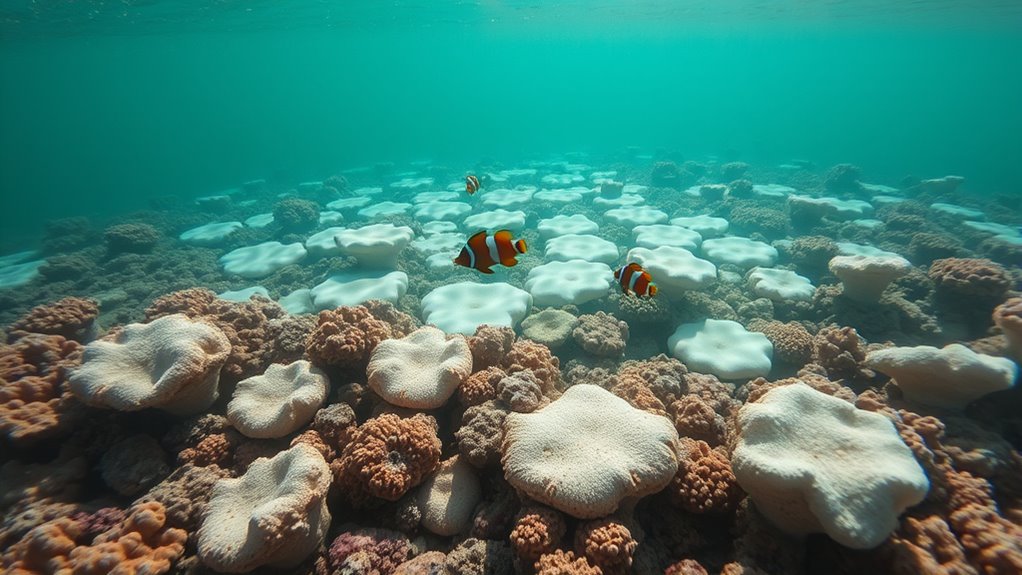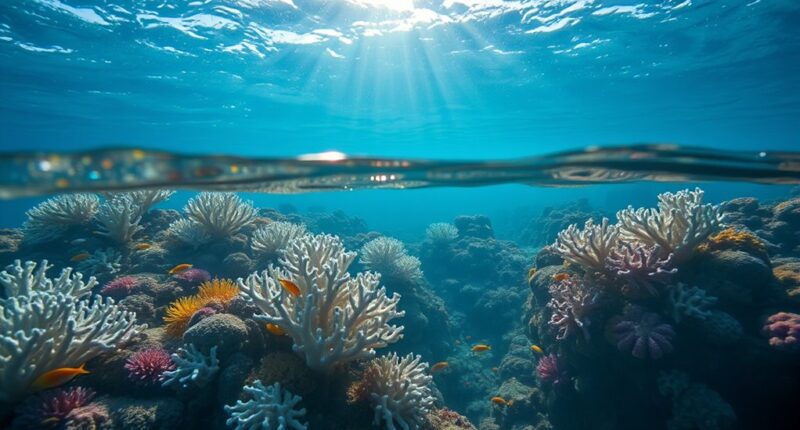Ocean acidification slowly threatens global fisheries by weakening shells of shellfish, like oysters and clams, and causing coral bleaching that damages crucial ecosystems. As CO₂ levels rise, the ocean becomes more acidic, disrupting marine food webs and reducing fish populations. This ongoing process quietly diminishes the productivity and health of our oceans, affecting communities that rely on fishing. To understand how these changes impact your food supply and economy, discover more about this silent threat.
Key Takeaways
- Ocean acidification weakens calcium carbonate structures in shellfish and coral reefs, reducing habitat and food sources for fish.
- The decline of coral reefs and shellfish populations disrupts marine ecosystems and diminishes biodiversity critical to fisheries.
- Acidic conditions impair fish growth and survival, leading to decreased fish stocks vital for global food security.
- Ecosystem degradation from acidification affects commercial and recreational fisheries worldwide.
- Long-term ocean health decline hampers resilience and recovery of fish populations, threatening sustainable fisheries.

Ocean acidification is a growing environmental issue caused by the absorption of excess carbon dioxide (CO₂) from the atmosphere into seawater. As CO₂ levels rise, the chemistry of the oceans shifts, making the water more acidic. This change doesn’t just affect the water’s pH; it directly threatens marine life, especially creatures with calcium carbonate shells or skeletons. You might notice that coral reefs are suffering from widespread coral bleaching, which weakens these vibrant ecosystems. Coral bleaching occurs when stressed corals expel their symbiotic algae, losing their color and essential energy sources. Without these algae, corals become more vulnerable to disease and die off more rapidly, leading to the degradation of entire reef systems. The loss of coral reefs has a ripple effect—disrupting habitats for countless marine species and affecting local fisheries that rely on these ecosystems.
Meanwhile, shellfish populations are experiencing significant declines. Shellfish like oysters, clams, and mussels depend on calcium carbonate to build their shells. As ocean acidity increases, it becomes harder for them to extract the minerals they need, impairing their ability to grow and survive. This decline isn’t just an ecological concern; it hits local economies hard, especially in coastal communities where shellfish farming is a primary livelihood. You may see fewer oysters on your plate or notice a downturn in the availability of shellfish at markets. The decline of these species also affects predators and other marine organisms that feed on them, further disrupting the food chain.
The effects of ocean acidification aren’t limited to coral bleaching and shellfish decline; they extend to entire marine ecosystems and the fisheries you depend on. As the foundation of many marine food webs weaken, fish populations can dwindle, impacting commercial and recreational fishing industries worldwide. You might not see the direct link day-to-day, but the long-term consequences threaten food security and economic stability for millions. The silent progression of acidification steadily erodes the resilience of marine environments, making it harder for ecosystems to recover from other stressors like warming temperatures and pollution. HEPA filtration can help improve indoor air quality but does not address oceanic changes. If you want to protect global fisheries and preserve the ocean’s biodiversity, addressing CO₂ emissions is essential. Otherwise, these subtle but destructive changes will continue to undermine the health of our oceans and the communities that rely on them.
Frequently Asked Questions
How Does Ocean Acidification Affect Deep-Sea Ecosystems?
You might not realize it, but ocean acidification impacts deep-sea ecosystems by weakening coral skeletons. Deep sea corals rely on carbonate to build their skeletons, and increased acidity reduces carbonate availability. As a result, these corals struggle to grow and survive, disrupting habitats for many marine species. This delicate balance is essential for the health of deep-sea ecosystems, and acidification threatens to destabilize it further.
Are There Any Species Resistant to Ocean Acidification?
You might wonder if any species resist ocean acidification. Some exhibit species resilience through adaptation strategies like adjusting their shell composition or altering metabolic processes. These natural resilience traits help them survive in changing conditions. While not all species can adapt, studying these resilient ones can offer insights into potential survival mechanisms, aiding conservation efforts and predicting future impacts on marine biodiversity amid ongoing acidification.
What Economic Sectors Are Most Impacted by Acidification?
You’ll find that fisheries management and the fishing industry are most affected by acidification. As shellfish and other marine species decline, economic resilience weakens, threatening livelihoods and local economies. You might see increased costs for sustainable practices and adaptation measures. These impacts ripple through related sectors like tourism and seafood processing, making it essential to strengthen management strategies and build resilience to safeguard economic stability amid changing ocean conditions.
Can Ocean Alkalinity Enhancement Mitigate Acidification?
Imagine giving the ocean a gentle boost—alkalinity strategies might be your answer. These mitigation techniques aim to increase seawater’s buffering capacity, helping to fight acidification. By adding substances like crushed minerals, you can potentially slow down harmful changes, protecting marine life and fisheries. While still in research, alkalinity enhancement offers a promising approach to counteract acidification’s silent threat, giving ecosystems a better chance to thrive.
How Does Acidification Influence Marine Food Webs?
You might not realize it, but acidification impacts marine food webs markedly. When ocean pH drops, coral bleaching becomes more frequent, destroying habitats essential for many species. It also hampers larval development in various marine organisms, reducing their survival chances. These changes disrupt predator-prey relationships and nutrient flow, weakening the entire ecosystem. Ultimately, acidification threatens the stability of marine food webs, affecting fish populations critical for global fisheries and human livelihoods.
Conclusion
If you ignore ocean acidification, you’re like a sailor ignoring a brewing storm—silent, yet deadly. It erodes marine ecosystems like a slow, relentless tide, threatening global fisheries and your future seafood supply. By understanding and acting now, you can help turn the tide back in our favor. Remember, the ocean’s health is the Earth’s heartbeat—neglect it, and we risk sinking into uncertain waters. Your actions can help steer us toward brighter, more resilient horizons.










